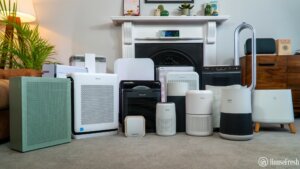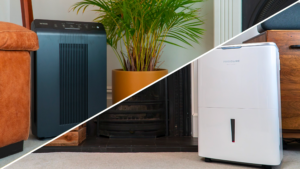Throughout history, man has become an increasingly indoor animal. According to the EPA, the average American now spends 90% of his time indoors, breathing in a stew of airborne pollutants that scientists and the public know relatively little about.
While shelters are designed to keep environmental hazards out, indoor spaces can be hotbeds of pollution. Pollutants from outside air can become trapped inside a home, along with molds, fungi, dust, and toxic gases that can harm and even kill their human occupants.
Common household activities like cleaning and cooking can also release harmful compounds that reduce air quality and have negative effects on human health. In some experiments, indoor air has been found to have concentrations of fine particle pollutants several times greater than outdoor air.
With the average human breathing approximately 10,000 liters of air per day, it is of utmost importance to ensure healthy air quality indoors.
While, as a field of research, indoor air quality is relatively overlooked in comparison to outdoor air, increased concern over the airborne transmission of disease during the COVID-19 pandemic has resulted in an uptick in interest in indoor air quality.
According to the Verdantix Global Corporate Survey 2020, 59% of real estate executives are planning to make new investments in air quality sensors and analytics in the wake of COVID-19.
As more workers return to the office, proper ventilation and air quality will become all the more important.
Below is our roundup of the most important statistics you should be aware of when it comes to indoor air quality.
10 indoor air quality trends to watch
The COVID-19 pandemic saw more people working from home than ever before. While many companies made investments in home office equipment for their workers, most homes lack the well-designed ventilation systems of office buildings, leaving many remote workers in indoor environments with poorer air quality than before the pandemic.
In one study, 100% of home offices were shown to have unacceptable levels of air pollution.
While indoor air quality remains relatively low in many homes, COVID-19 has also led to a surge in interest in the subject. Google searches for indoor air quality spiked in 2020 and 2021, and the market for indoor ventilators skyrocketed.

We identified some of the biggest trends in indoor air quality from the last few years:
- Research on air quality control has shifted from outdoor to indoor environments, as more people around the world move to dense urban areas. (International Journal of Environmental Research and Public Health)
- Air quality in home offices is often worse than in office buildings – In one recent study, particulate matter was found to exceed the recommended maximum of 12 µg/m3 in 100% of home offices used for remote work during the COVID-19 pandemic. (Atmosphere)
- Google searches for indoor air quality in the United States rose 65% during the pandemic, and peaked in September 2021. (Google Trends)
- Finland searches for “indoor air quality” way more than any other country — Hong Kong and Ethiopia follow, but with notable fewer searches. (Google Trends)
- The global residential air purifier market grew to 21 million in 2021— That’s up from roughly 6 million units in 2015. (Statista)
- Just 27% of families experiencing indoor breathing issues will attempt to improve them by introducing an air purifier. (Current Allergy and Asthma Reports)
- 40% of consumers will spend more than $200 on an air purifier for their home. (Kaz, Inc.)
- 46% of two-parent homes have an air purifier — while just 3% of single-parent homes have one. (Kaz, Inc.)
- Consumer products account for 38% of smog-forming emissions — more than the 33% caused by gas and diesel combustions. (Science News)
- Concentrations of volatile organic compounds (VOC’s) are at least 10 times higher indoors than outdoors. (International Journal of Environmental Research and Public Health)
6 key indoor air quality facts and statistics
According to a number of public health specialists, public awareness around indoor air quality is relatively low. While laws controlling outdoor air pollution have been around for decades, there are relatively few regulations dealing with the indoor environments in which we spend the majority of our time.
There is voluminous research on how different natural processes and human activities affect outdoor air quality, but there is comparatively little research on what causes indoor air pollution or even how best to measure it.
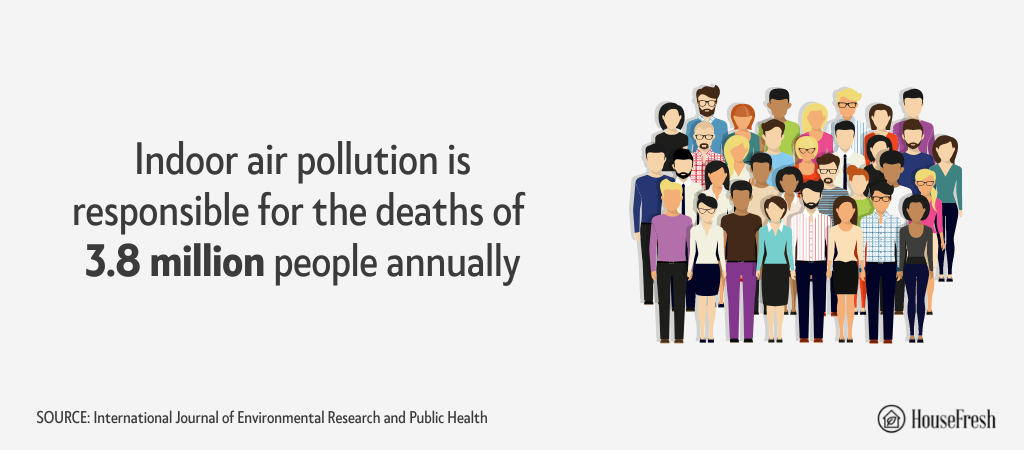
In light of this gap in public health information, it is important to know some of the basic facts about indoor air quality and its effects on health.
- Indoor air pollution is responsible for the deaths of 3.8 million people annually. (International Journal of Environmental Research and Public Health)
- Mortality due to indoor air pollution is 50% higher in women than men — Women spend more time indoors on average, and are exposed to more indoor irritants. (Archives of Public Health)
- According to air quality researchers, minimum ventilation rate standards (the minimum number of times the air in a room should be replaced by a ventilator) are rarely met in the United States. (Nature)
- Breath circulates in small spaces – in a crowded room with no windows, one in every seven breaths a person breathes is air another person had breathed out. (RNZ)
- Exposure to household air pollution almost doubles the risk for childhood pneumonia. (WHO)
- Outdoor pollution events like wildfires and 4th of July fireworks can increase indoor air pollution two to three-fold. (The University of Utah)
6 facts about indoor air pollution sources
Some of the most ubiquitous household products are also some of the biggest contributors to indoor air pollution. Everyday activities like cooking, cleaning, and even petting your dog or cat have been shown to result in statistically significant increases in indoor air pollution.
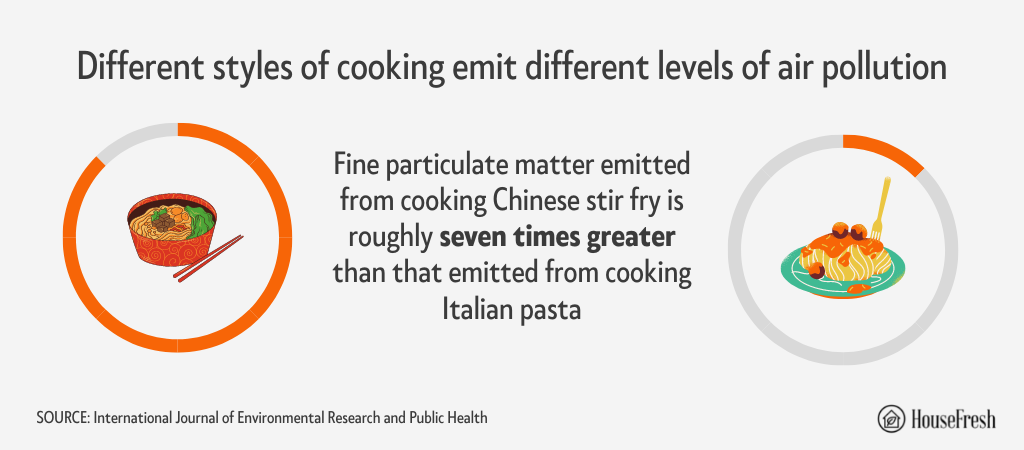
Knowing the numbers behind the causes and effects of indoor air pollution can be a critical step towards controlling it.
- Smoking is a major source of indoor particulate matter, and is associated with an increase in PM2.5 concentration of 25 to 45 µg /m3. (International Journal of Environmental Research and Public Health)
- Cooking is a common source of indoor air pollution — According to researchers, articles emitted from cooking account for approximately 30% of indoor fine particulate matter. (International Journal of Environmental Research and Public Health)
- Different styles of cooking emit different levels of particulate matter — In one experiment, fine particulate matter emitted from cooking Chinese stir fry was roughly seven times greater than that emitted from cooking Italian pasta. (International Journal of Environmental Research and Public Health)
- Consumer products like hairspray, cleaning liquids, and air fresheners on average contribute 10% to 20% of volatile organic compounds in indoor environments. (GreenFacts)
- Everyday chores can create indoor air pollution — A few minutes of mopping with cleaning products can generate as many airborne particles as vehicles on a city street. (Science)
- Major sources of indoor air pollution include exhaust from gas stoves and fireplaces, candles, air fresheners, tobacco smoke, laser printers, household cleaning products, pollen, mold spores, and dust mites. (University of Massachusetts Amherst)
10 U.S. household air quality statistics
America invented the modern office building, and introduced many of the innovations that are now standard regulation for public indoor spaces. But while the United States has been at the vanguard of indoor air quality innovation, many Americans are relatively uninformed about ventilation and proper maintenance of indoor spaces, according to a recent survey.
Still, the degree of awareness varies across the country, with the volume of Google searches for “indoor air quality” in some states outnumbering others by more than 10 to 1.
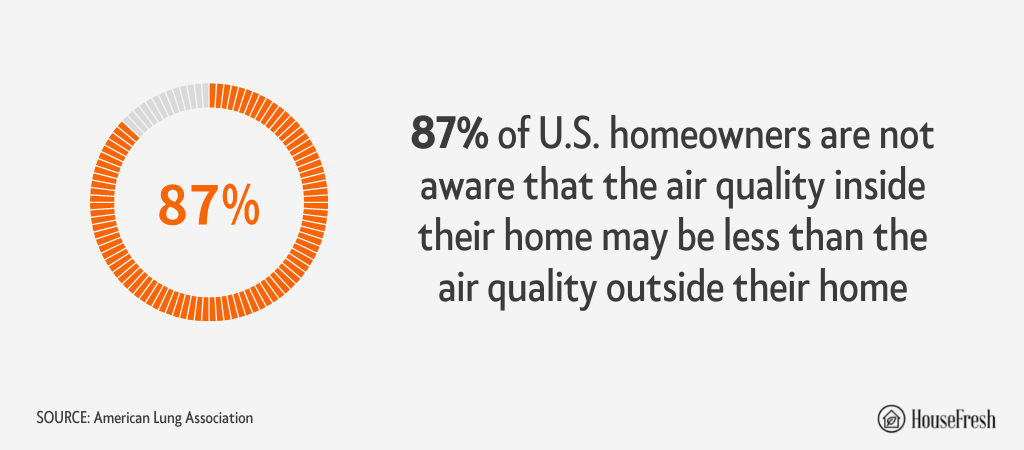
These statistics help paint a picture of indoor air quality and awareness in the United States.
- 87% of U.S. homeowners are not aware that the air quality inside their home may be less than the air quality outside their home. (American Lung Association)
- $75 billion a year is lost in productivity due to adverse health effects caused by poor air quality in buildings in the United States. (Atmosphere)
- 29% of Americans never change the air filter in their home. (The Zebra)
- 82% of Americans fail to change their air filter monthly. (The Zebra)
- 1 in 5 Americans say it’s not important to change their air filter. (The Zebra)
- In the United States, Google searches for indoor air quality are greatest in Oregon, and lowest in Iowa. (Google Trends)
- New York is the state with the most premature deaths due to indoor air pollution from fuel combustion in buildings — followed by Pennsylvania, California, Illinois, and New Jersey. (RMI)
- The air purifier manufacturing industry is worth about $7 billion in the United States. (IBIS World)
- There are about 474 businesses involved in the manufacturing of air purification equipment in the United States. (IBIS World)
- In the United States, the average cost of a whole-home air purification system ranges from $400 to $4,000. (HomeGuide)
9 U.K. household air quality statistics
In 1952, a number of natural and man-made factors combined to envelop London in a thick layer of smog for several days. The pollution event – known as the Great Smog – resulted in thousands of deaths, and ultimately led to the passage of the UK’s Clean Air Act 1956.
But while the UK’s mix of urbanization and industry has put it at the center of the regulatory debate over clean air, much of the country still suffers from poor air quality, indoors and out.
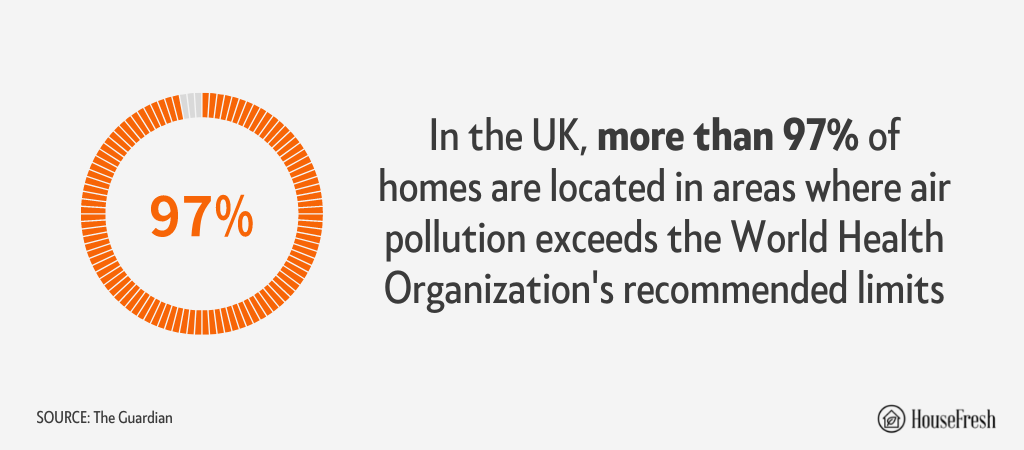
By some estimates, Britons spend even more of their day inside than Americans, making knowing the facts about indoor air quality in the United Kingdom all the more important.
- Britons spend on average 95% of their time indoors on weekends. (Ribble Cycles)
- In the UK, more than 97% of homes are located in areas where air pollution exceeds WHO-recommended limits. (The Guardian)
- The UK’s legal limit for fine particulate matter is five times higher than the World Health Organization limit. (The Guardian)
- In the UK, Plymouth is the city with the worst air quality — while Llangefni has the best air quality. (AQI)
- It is estimated that tobacco smoke in the home causes 11,000 deaths every year in the UK. (UK Government)
- Residents of the United Kingdom search “indoor air quality” on Google at about one-third the rate of Americans. (Google Trends)
- In the United Kingdom, Google searches for indoor air quality are greatest in Northern Ireland, and least in Wales. (Google Trends)
- Residential radon exposure contributes to about 3% of lung cancer deaths in the UK. (UK Government)
- In the United Kingdom, ultrafine particle pollution levels are on average 3.5 times higher inside than outside. (Air Quality News)
8 indoor air quality and health statistics
While the COVID-19 pandemic brought indoor air quality into the spotlight, indoor air pollutants have long been a serious public health issue, causing serious health problems and costing billions in health care spending.
Researchers have yet to quantify the exact health toll of breathing indoor air for 90% of the day, but some statistics help shine a light on the public health situation.

We’ve rounded up several statistics showing the effects of indoor air quality on health.
- The WHO estimates that indoor air pollution is responsible for 2.7% of the years of life lost to early death worldwide. (MIT)
- Particulate matter is mostly generated from combustion activities and cleaning activities — they can lead to premature death in people with heart or lung disease, irregular heartbeats, and aggravated asthma. (International Journal of Environmental Research and Public Health)
- Volatile organic compounds are generated from paints, fuels, plastics, and cleaning products — they can cause eye, nose, and throat irritation, headaches, and liver damage. (International Journal of Environmental Research and Public Health)
- Exposure to indoor radon can cause an increase in lung cancer risk from 3% to 14%. (International Journal of Environmental Research and Public Health)
- Indoor air pollution increases the risk of childhood acute lower respiratory infections by 78%. (International Journal of Environmental Research and Public Health)
- Indoor air quality problems cost an estimated $15 billion a year in direct medical costs. (Burroughs and Hansen)
- Air pollution is a major cause of hospitalization — An estimated 15% of admissions to hospital emergency rooms could be attributed to dust mites and other airborne allergens. (Burroughs and Hansen)
- Air pollution has been shown to be associated with negative effects on cognitive function — A 25% increase in particulate matter has been associated with a 0.82% decrease in response times in office workers. (Environmental Research Letters)
4 facts about the history of air purification
While there are few comprehensive regulations dealing with indoor air quality, concerns over how to control pollution in indoor environments date back to antiquity.
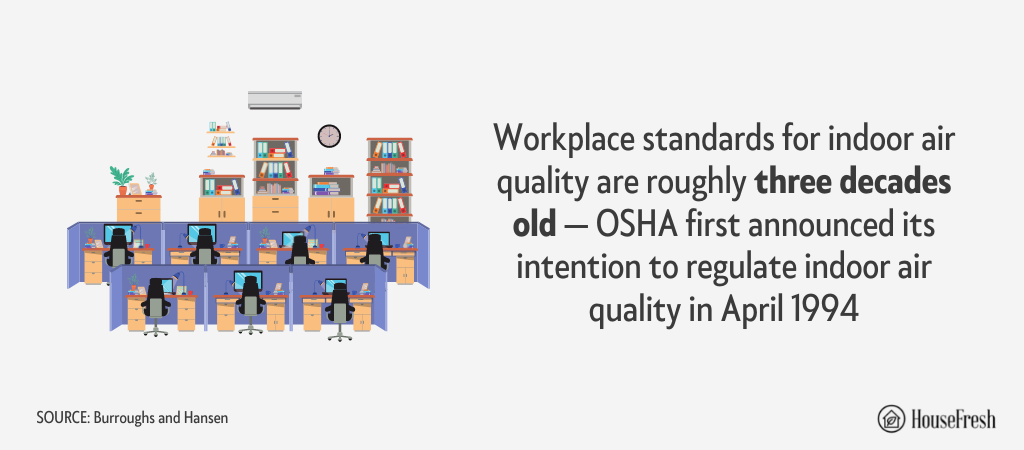
We rounded up the most interesting facts on the history of air purification to see how concerns over indoor air quality have evolved over the years.
- Egyptian historians have found evidence of modern social attitudes toward indoor air quality dating back to 1500 B.C. Burroughs and Hansen)
- The first air purification systems appeared in the 1850s in the form of charcoal-based masks worn by coal miners. (IQAir)
- Modern ventilation technology began with the development of high-efficiency particulate arrestance (HEPA) in the 1940s, as part of an effort to shield soldiers from atomic radiation during World War II. (IQAir)
- Workplace standards for indoor air quality are roughly three decades old — OSHA first announced its intention to regulate indoor air quality in April 1994. (Burroughs and Hansen)
9 authoritative air quality reports you should read
COVID-19 is not the first time indoor air quality became a hot topic in the research world. Environmental regulations in the 1970s and concerns over ambient air pollution in the wake of the September 11th terrorist attacks both inspired new research in the field, resulting in a number of new insights and landmark studies on indoor quality.
To help you stay informed, we rounded up some of the most authoritative air quality reports you should read.
- Indoor Particulate Matter (EPA)
- The Inside Story: A Guide to Indoor Air Quality (EPA)
- Air Cleaners and Air Filters in the Home (EPA)
- Care for Your Air: A Guide to Indoor Air Quality (EPA)
- Guide to Air Cleaners in the Home (EPA)
- Indoor Air Quality and Health Outcomes in Employees Working from Home during the COVID-19 Pandemic: A Pilot Study
- Measurement of Ultrafine Particles and Other Air Pollutants Emitted by Cooking Activities
- Indoor Air Pollution, Related Human Diseases, and Recent Trends in the Control and Improvement of Indoor Air Quality
- Overview of HOMEChem: House Observations of Microbial and Environmental Chemistry
A cleaner future
Concerns over indoor air quality are not new. Historians speculate that early humans likely struggled to contain combustion contamination from fires in caves, and have found notations documenting the effects of airborne dust on health dating back thousands of years.
While the dwellings have changed since antiquity, the basic facts around indoor air quality have not. Indoor spaces are complex habitats, consisting of a physical building, environmental setting, HVAC system, and air pathways, as well as occupants and their activities. COVID-19 has made apparent the lack of proper ventilation infrastructure in public and private buildings, but has also placed air quality issues at the center of the public health conversation. As indoor air quality becomes more relevant, staying informed becomes all the more important.

SOURCES
- Air Quality Index. (2022). United Kingdom Air Quality Index (AQI). aqi.in
- Barrett, T. (2019). UK homes ‘toxic boxes’ due to indoor air pollution. airqualitynews.com
- Burroughs, H.E. & Hansen, S. (2004). Managing Indoor Air Quality. books.google.com
- Carrington, D. (2022). Dirty air affects 97% of UK homes, data shows. theguardian.com
- Dida, G. et. al. (2022). Factors predisposing women and children to indoor air pollution in rural villages, Western Kenya. archpublichealth.biomedcentral.com
- Duflo, E. et. al. (2008). Indoor Air Pollution, Health and Economic Well-being. economics.mit.edu
- Gabrielsen, P. (2021). How outdoor pollution affects indoor air quality. attheu.utah.edu
- Gaille, B. (2018). 22 Air Purifier Industry Statistics, Trends & Analysis. brandongaille.com
- Google Trends. (2022). Google Trends: Indoor air quality. trends.google.com
- GreenFacts. (2008). Indoor Air Quality. ec.europa.eu
- Gruenwald, T. & Mushegan, S. (2021). New York Emits More Building Air Pollution Than Any Other State. rmi.org
- Hamers, L. (2018). Household products make surprisingly large contributions to air pollution. sciencenews.org
- Hancock, F. (2022). Whose breath are you breathing? Rnz.co.nz
- HomeGuide. (n.d.) How much does a whole-house air purifier cost to install? homeguide.com
- IBISWorld. (2021) Air Purification Equipment Manufacturing Industry in the US. ibisworld.comIQAir. (2022). Do air purifiers work? Air purifier myths and facts debunked. Iqair.com
- Laurent, J. et. al. (2021). Associations between acute exposures to PM2.5 and carbon dioxid indoors and cognitive function in office workers: a multicountry longitudinal prospective observational study. iopscience.iop.org
- Lewis, D. (2021). Why indoor spaces are still prime COVID hotspots. nature.com
- Meyer, S. (2022). Take a Deep Breath: 82% of Americans Fail to Change Their Air Filter Monthly. thezebra.com
- Ribble. (2017). The Not-So Great Outdoors? ribblecycles.co.uk
- Roh, T. et al. (2021). Indoor Air Quality and Health Outcomes in Employees Working from Home during the COVID-19 Pandemic: A Pilot Study. Mdpi.com
- Stokstad, E. (2022). Mopping can create air pollution that rivals city streets. science.org
- Sublett, J. (2011). Effectiveness of Air Filters and Air Cleaners in Allergic Respiratory Diseases: A Review of the Recent Literature. Ncbi.nlm.nih.gov
- Supply House Times. (1999). Homeowners unaware of indoor air pollution. supplyht.com
- Tran, V. et. al. (2020). Indoor Air Pollution, Related Human Diseases, and Recent Trends in the Control and Improvement of Indoor Air Quality. ncbi.nlm.nih.gov
- UK Parliament. (2010). UK Indoor Air Quality. parliament.uk
- UMassAmherst. (n.d.) Indoor Particulate Matter. ehs.umass.edu
- U.S. Environmental Protection Agency. (1989). Report to Congress on Indoor Air Quality. nepis.epa.gov
- Vijayan, V. et. al. (2015). Enhancing indoor air quality –The air filter advantage. Ncbi.nlm.nih.gov
- World Health Organization. (2022). Household air pollution and health. who.int
- Zhang, Q. et. al. (2010). Measurement of Ultrafine Particles and Other Air Pollutants Emitted by Cooking Activities. ncbi.nlm.nih.gov






